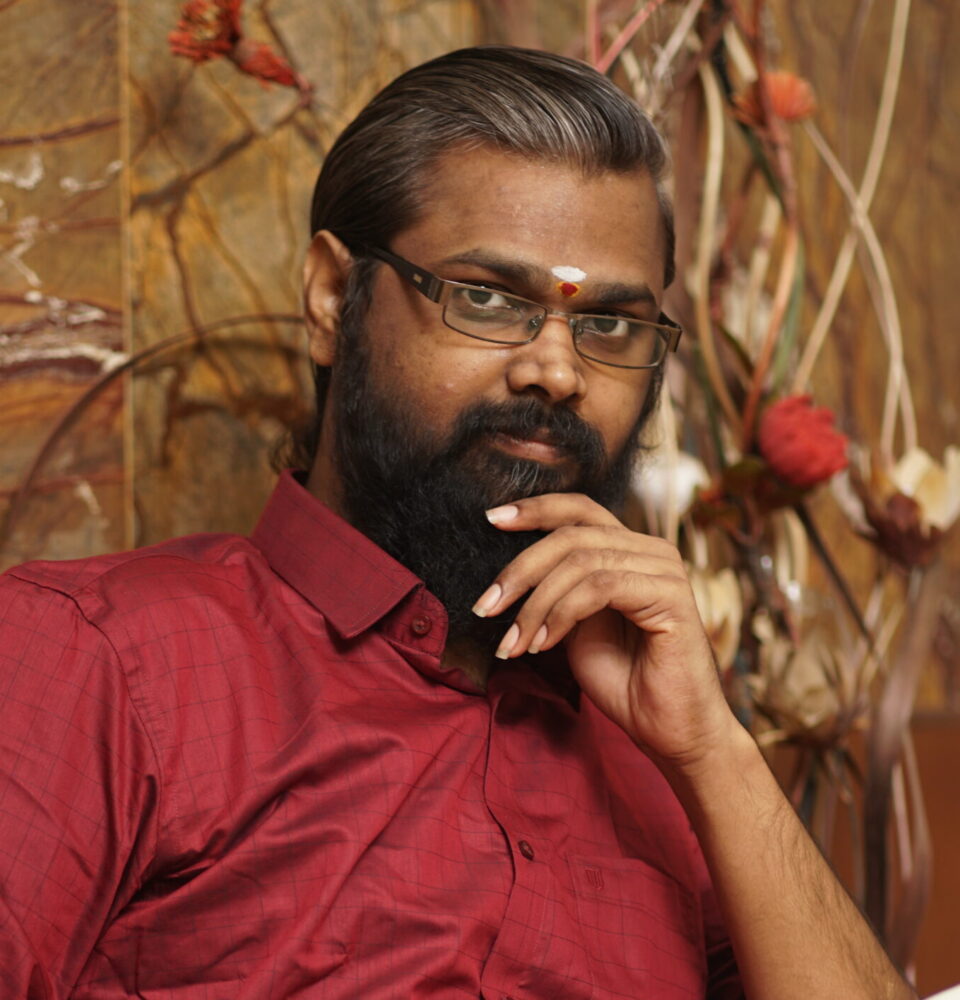
In the heritage-soaked town of Tirunelveli, Tamil Nadu, art has found a new purpose through the work of A. Veera Ragavan, fondly known as AVR in the Tamil film industry. His journey is not just that of a designer, but of a storyteller, a bridge-builder, and a believer in unity through creativity.
At a time when division often dominates headlines, AVR has quietly created something extraordinary—a logo that symbolically unites Hinduism, Islam, and Christianity. A design that brings together three of the world’s major faiths, interwoven with the Tamil and English scripts, speaking volumes without uttering a word. It is a rare piece of art that transcends language, religion, and boundaries—built not to blend beliefs but to honour their peaceful coexistence.
From Equations to Emotions
AVR’s path didn’t begin in design. A trained engineering graduate, he followed a well-trodden road of logic and discipline, yet something deeper called to him—something far less structured, far more expressive.
Cinema, culture, and art had long fascinated him. So, with conviction in his vision, he made the life-altering decision to leave behind the safety net of a traditional career and enter the vast, uncertain world of creativity. It was a leap driven by purpose, not popularity.
In the past seven years, AVR has emerged as a notable visual designer in the Tamil film industry, known especially for his striking poster and title designs. His creations are visually compelling, yet grounded in emotion, drawing on Tamil culture and cinematic depth.
But his most meaningful creation would be born not on a film set—but during a moment of national mourning.
When Grief Became a Muse
In 2015, as India bid farewell to one of its most revered leaders, Dr. A.P.J. Abdul Kalam, AVR was among the many who attended the late President’s funeral in Rameswaram. What he witnessed there moved him profoundly.
People of all faiths stood side by side, united not by religion, but by respect—for a man who belonged to everyone. That image left a permanent imprint on AVR’s heart.
“It was more than a funeral. It was a moment of truth,” he says. “That day, I saw what unity really means.”
It planted a seed in his mind—what if this unity could be captured visually? What if a single symbol could speak for all?
The Creation of a Sacred Symbol
What followed was months of thoughtful design. AVR sought to create a symbol that would represent spiritual harmony, yet retain the individual sanctity of each religion. The result was a carefully crafted logo integrating the ‘Om’, the Crescent Moon and Star, and the Christian Cross—arranged with balance, respect, and meaning.
The inclusion of Tamil and English text added another layer: cultural grounding and global accessibility. Each colour and curve had intent. Every decision in the design was deliberate—because this was not just a piece of art. It was a message.
A message that said: “We can coexist—not by losing ourselves, but by respecting each other.”
Global Recognition for a Local Voice
In 2024, AVR’s logo earned him recognition in the World Book of Records. The award marked a career milestone, not just for its prestige, but for validating a deeply personal vision—that art, when rooted in truth, can speak to the world.
Still, for AVR, the acclaim is not the destination.
“Recognition is encouraging,” he reflects. “But my real reward is when someone sees the design and says, ‘This speaks to me.’ That’s when I know it’s working.”
His work has since circulated through schools, peace campaigns, social groups, and digital platforms—quietly building bridges where once there were walls.
Art with Intent
AVR’s design philosophy is deeply intentional. In a fast-paced industry that often favours trend over truth, he stands apart. Each of his projects—whether a film poster or a symbolic logo—is approached with heart, history, and human connection.
He believes that true design doesn’t just capture attention—it carries emotion.
This belief also drives his mentoring of young creatives. He encourages them to look beyond the commercial and tap into what they truly want to express.
“Don’t design to impress. Design to connect,” he advises. “Let your art have a voice—and make sure it says something worth hearing.”
More Than an Artist — A Messenger
From the narrow lanes of Tirunelveli to national and now international recognition, AVR’s story is not just inspiring—it’s transformative. His art is not just a product of talent, but of awareness and responsibility.
He reminds us that in a world growing louder with division, silent symbols can sometimes speak the loudest truths.
His journey is a tribute to the power of following one’s calling, no matter how unconventional. It’s about choosing to create not for fame, but for impact—using design not to decorate, but to communicate.
A Lasting Message in Every Line
Today, AVR continues his work in cinema and beyond, pushing the boundaries of what design can do. He sees every project as an opportunity—not just to tell a story, but to build a bridge.
And in doing so, he leaves us with a powerful reminder:
That the strength of any society lies not in its sameness, but in how it celebrates its differences.
That unity doesn’t ask us to be identical—only kind.
And that, sometimes, a single image can hold the hope of a more connected world.

